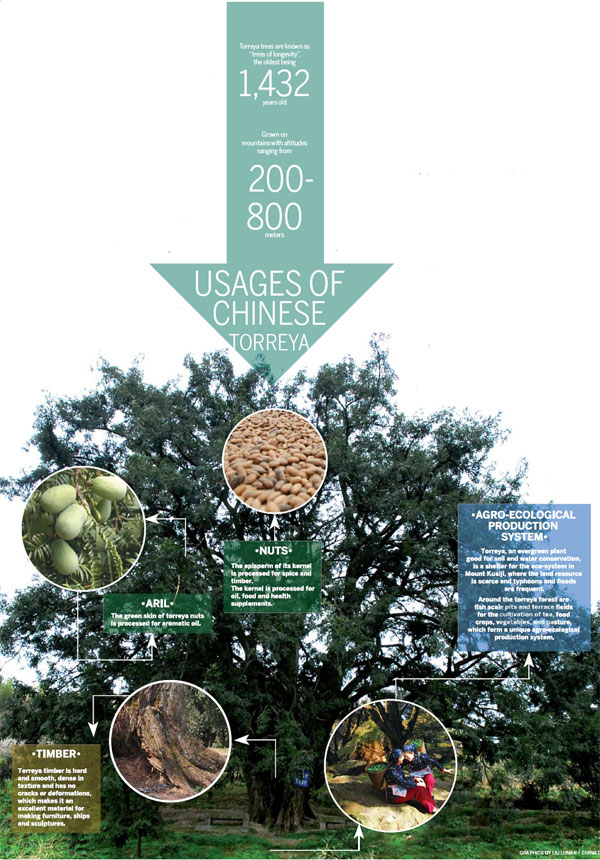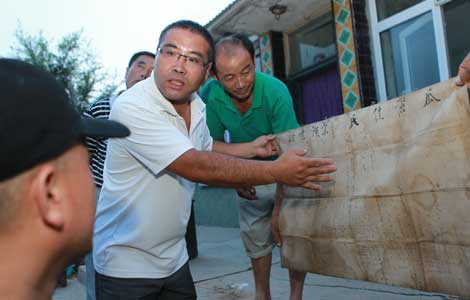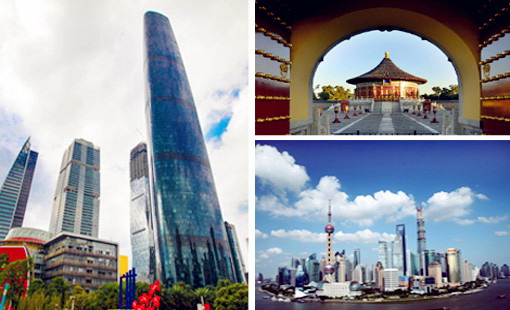Going nuts
Updated: 2013-08-15 08:01
By Sun Yuanqing (China Daily)
|
||||||||

The branding of Mount Kuaiji's ancient Chinese torreya nuts has brought fame and fortune to the local community. But the new class of entrepreneurs must maintain a delicate balance with nature, Sun Yuanqing reports.
When Luo Guanjun was growing up in the Mount Kuaiji area in Zhejiang province, he found it hard to appreciate the beauty of the nearby forest. The trees were a symbol of his family's poverty: He'd seen a huge sack of torreya nuts that had taken two years to grow and process exchanged for just a few rice coupons.
At 16, Luo left his home in Zhaojiazhen in the Mount Kuaiji area to seek his fortune elsewhere. Working in a clothing factory in Shenzhen, Guangdong province, he learned about branding and quality control. Five years later, he returned to the torreya forest to put these ideas into practice.
Now Luo's marketing know-how has raised awareness about the health benefits of torreya nuts, and transformed the trees into a gold mine for the villagers.
A local household now typically raises three or four torreya trees, which can support the family for the whole year. The trees have lifted the entire community out of the "era of starvation" as Luo described his childhood.
"The torreya trees have changed my life and the lives of my fellow villagers," he says. "Now they are ready to reach out to more people."
Agricultural heritage
Luo was speaking a few weeks after the Food and Agriculture Organization of the United Nations selected Mount Kuaiji's ancient Chinese torreya as a Globally Important Agricultural Heritage System.
The GIAHS was initiated in 2002 to protect traditional farming processes, which are at risk of disappearing in the face of rural migration and rapid urbanization. China now has eight agricultural heritage sites.
Chinese torreya trees are commonly found around 31 degrees north latitude. But while the wood of the trees is used for logs and ornaments, only the torreya in the Mount Kuaiji area in Shaoxing, Zhejiang province, produce savory fruit. This is because they have been carefully selected and grafted for more than 2,000 years.
Mount Kuaiji is home to more than 100,000 ancient Chinese torreya trees, also known as "trees of longevity". Among them, 72,000 are more than 100 years old, and thousands are more than 1,000 years old. The longest living Chinese torreya tree known is 1,432 years old. It is the oldest grafted tree in China, and it still produces 500 kilograms of fruit every year.
"Chinese torreya are a living fossil of ancient grafting and artificial selection techniques," says Tong Pinzhang, a senior engineer with the Zhuji Forestry Bureau. "But it remains a mystery how and when the first Chinese torreya were grafted."
Shelter of ecosystem
The torreya trees are also a mainstay of the ecosystem in Mount Kuaiji, where land is scarce and typhoons and floods are frequent. Along with the trailing terraced fields, tea gardens and fish-scale pits, they help protect the unique ecosystem.
"Terraced fields by themselves lead to soil erosion in the mountains. So we grow trees as well, because they not only generate incomes, they also prevent natural disasters," says Zhang Xiaojun, deputy secretary general of the municipal government of Shaoxing.
"There is a saying here that raising a torreya tree is sometimes better than raising a son," says Tong, the engineer, "as the trees will support you throughout your life time no matter what. So the torreya farmers care for them just like their own children."
Bearing fruit
It takes 15 years before a torreya tree becomes productive, and it takes 18 months for the fruits to mature. Every September, the whole village will work around the clock for a month to pick and process the harvest.
Last year, 80 percent of the annual per capita income in Zhaojiazhen, more than 8,000 yuan ($1,306), came from the torreya trees. The total output of fruit was 1,313 tons, with a value of 625 million yuan ($101 million).
Because the torreya trees are usually very tall and covered with moss, local people have invented tools like the "centipede ladder" and hanging bamboo baskets for the picking season. However, accidents still happen from time to time, making the harvest a time for prayers.
The process of turning the fresh torreya fruit into tasty nuts takes 11 steps, including peeling, washing, drying and stir-frying. It is said that the torreya nuts fried by local farmers taste the best because they know how to control the heat and how long they need to be cooked based on the smell of the torreya. Since the 1980s, the annual production of torreya nuts has increased from 50 tons to more than 1,000 tons.
Branding counts
However, the increased output was not enough to enable the village to prosper until the China Torreya Industry Association was founded in the early 1990s under Luo's guidance.
"When I first went to Shenzhen, I was shocked to find a plain cotton shirt could sell for hundreds of dollars. That's how I came to recognize the value of branding," Luo says. "It's the same with nuts. A small pack of pistachio nuts with an American brand would sell for as much as a sack of the torreya nuts in my hometown."
When Luo returned home in 1993 no torreya brand existed, but he got a national trademark the following year.
He collected only best torreya fruit from farmers at a price higher than before and standardized the process to produce the nuts, which he then sold in exquisite small packages.
The retail price of torreya nuts has rocketed over the last decade from 20 yuan to more than 600 yuan a kilogram. The nuts from the oldest torreya tree now sell for 10 yuan a piece.
Luo says the future of torreya nuts is in advanced processing.

The nuts can be made into capsules that are effective for the prevention of high blood pressure, hyperglycemia and hyperlipemia. They also contain paclitaxel, which can be used for cancer prevention, he says.
"For old people who are not able to chew, we are developing torreya paste, something you can eat instantly when mixed with hot water," Luo says. "The green skin of the torreya nuts contains essential oil that can be developed into shampoo."
In 2012, more than 100,000 people visited Zhaojiazhen town, but Luo is cautious about developing large-scale tourism in the torreya forest.
"When it comes to the exploitation of 1,000-year-old torreya trees, we can't afford mistakes," he says.
"Some of the tourists casually break off leaves and even branches for souvenirs. If I were the tree, I would be weeping."
Contact the writer at sunyuanqing@chinadaily.com.cn
Zhang Jianming in Hangzhou contributed to the story.

(China Daily USA 08/15/2013 page8)

 Spielberg has desire to work with Zhang Yimou
Spielberg has desire to work with Zhang Yimou
 Requiem ceremony for former comfort woman
Requiem ceremony for former comfort woman
 Egypt forces crush protesters
Egypt forces crush protesters
 Two killed in fiery crash of UPS cargo jet
Two killed in fiery crash of UPS cargo jet
 Yao dreams of sports for fun with towering charity
Yao dreams of sports for fun with towering charity
 Re-enacting ancestors' journey to the west
Re-enacting ancestors' journey to the west
 Special bus seat for breast-feeding mothers
Special bus seat for breast-feeding mothers
 Northern exposure
Northern exposure
Most Viewed
Editor's Picks

|

|

|

|

|

|
Today's Top News
US asks China's help on DPRK issues
Movie tax flack is settled
Manning 'sorry' for US secrets breach
China to be world's No 1 consumer
Gold rises on physical buying from Asia
Millionaires hold dimmer view: Survey
China to probe foreign automakers
Snowden case not to affect US-Russia talks
US Weekly

|

|




